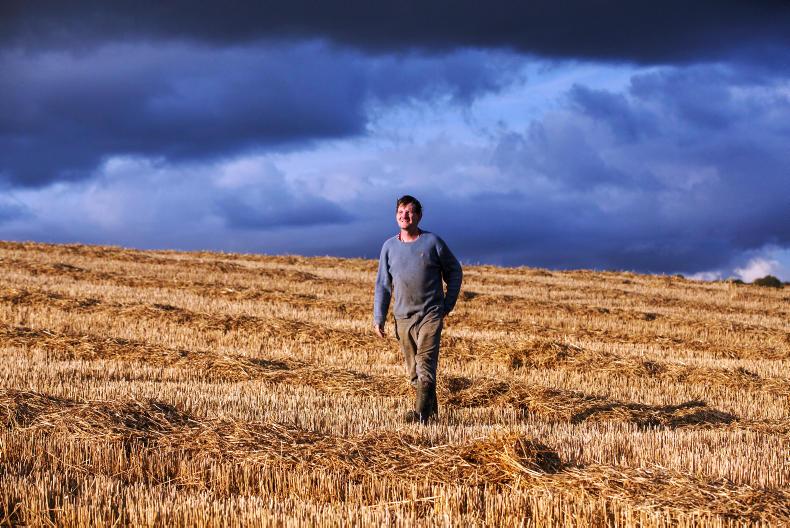Despite grain stocks worldwide being at an all-time high, another season of heavy rain and unfavourable conditions has left tillage farmers and their representatives very concerned about the viability of the sector.
Adverse weather conditions in recent years have had a detrimental effect on Irish harvests and on Tuesday the IFA and the Irish Grain Growers’ Association (IGGA) put forward submissions on grain to the Oireachtas committee on agriculture.
The IFA estimates that the area of land sown over the last 10 years has decreased by over 142,000 acres, equivalent to almost 20%.
It also states that sowings in 2017 were down 37,000 acres compared with the previous year.
The 2017 harvest has been even worse than last year for many tillage farmers
This continues last year’s downturn in the tillage sector, as overall production in 2016 of wheat, oats and barley decreased by 12.3%, according to the Central Statistics Office.
“Unfortunately, as I speak, a number of growers are struggling to complete this year’s grain harvest and save straw as weather has taken a turn for the worse.
“It is vitally important that we collectively devise an action plan to address the serious and deepening income crisis in the Irish tillage farming sector, as we are now into the fifth consecutive year of low grain prices,” IFA grain committee chair Liam Dunne said.
Earlier this year, the IFA held a sit-in at the Department of Agriculture in Dublin protesting the level of compensation offered to farmers after the poor harvest of 2016.
The IGGA estimates that grain farmers are currently earning €2/hour.
Costs spiral
The 2017 harvest has been even worse than last year for many tillage farmers.
In many instances, particularly along the western seaboard, tillage farmers are in salvage operation just to get crops out of the fields.
In addition to the inclement weather, tillage farmers have had to deal with the increased fertiliser prices now accounting for almost 40% of their variable costs.
It is understood that farm bodies could make a push for a further tillage compensation package to ease the financial pressure on farmers.
Currently, under 9% of agricultural land is being used for tillage. However, the IGGA believes that the tillage sector has the potential to grow with demand for malt expected to rise given the projected increase in Irish whiskey of 300% by 2030.
Read more
Healy calls for nitrates flexibility and lime scheme
Despite grain stocks worldwide being at an all-time high, another season of heavy rain and unfavourable conditions has left tillage farmers and their representatives very concerned about the viability of the sector.
Adverse weather conditions in recent years have had a detrimental effect on Irish harvests and on Tuesday the IFA and the Irish Grain Growers’ Association (IGGA) put forward submissions on grain to the Oireachtas committee on agriculture.
The IFA estimates that the area of land sown over the last 10 years has decreased by over 142,000 acres, equivalent to almost 20%.
It also states that sowings in 2017 were down 37,000 acres compared with the previous year.
The 2017 harvest has been even worse than last year for many tillage farmers
This continues last year’s downturn in the tillage sector, as overall production in 2016 of wheat, oats and barley decreased by 12.3%, according to the Central Statistics Office.
“Unfortunately, as I speak, a number of growers are struggling to complete this year’s grain harvest and save straw as weather has taken a turn for the worse.
“It is vitally important that we collectively devise an action plan to address the serious and deepening income crisis in the Irish tillage farming sector, as we are now into the fifth consecutive year of low grain prices,” IFA grain committee chair Liam Dunne said.
Earlier this year, the IFA held a sit-in at the Department of Agriculture in Dublin protesting the level of compensation offered to farmers after the poor harvest of 2016.
The IGGA estimates that grain farmers are currently earning €2/hour.
Costs spiral
The 2017 harvest has been even worse than last year for many tillage farmers.
In many instances, particularly along the western seaboard, tillage farmers are in salvage operation just to get crops out of the fields.
In addition to the inclement weather, tillage farmers have had to deal with the increased fertiliser prices now accounting for almost 40% of their variable costs.
It is understood that farm bodies could make a push for a further tillage compensation package to ease the financial pressure on farmers.
Currently, under 9% of agricultural land is being used for tillage. However, the IGGA believes that the tillage sector has the potential to grow with demand for malt expected to rise given the projected increase in Irish whiskey of 300% by 2030.
Read more
Healy calls for nitrates flexibility and lime scheme






 This is a subscriber-only article
This is a subscriber-only article










SHARING OPTIONS: